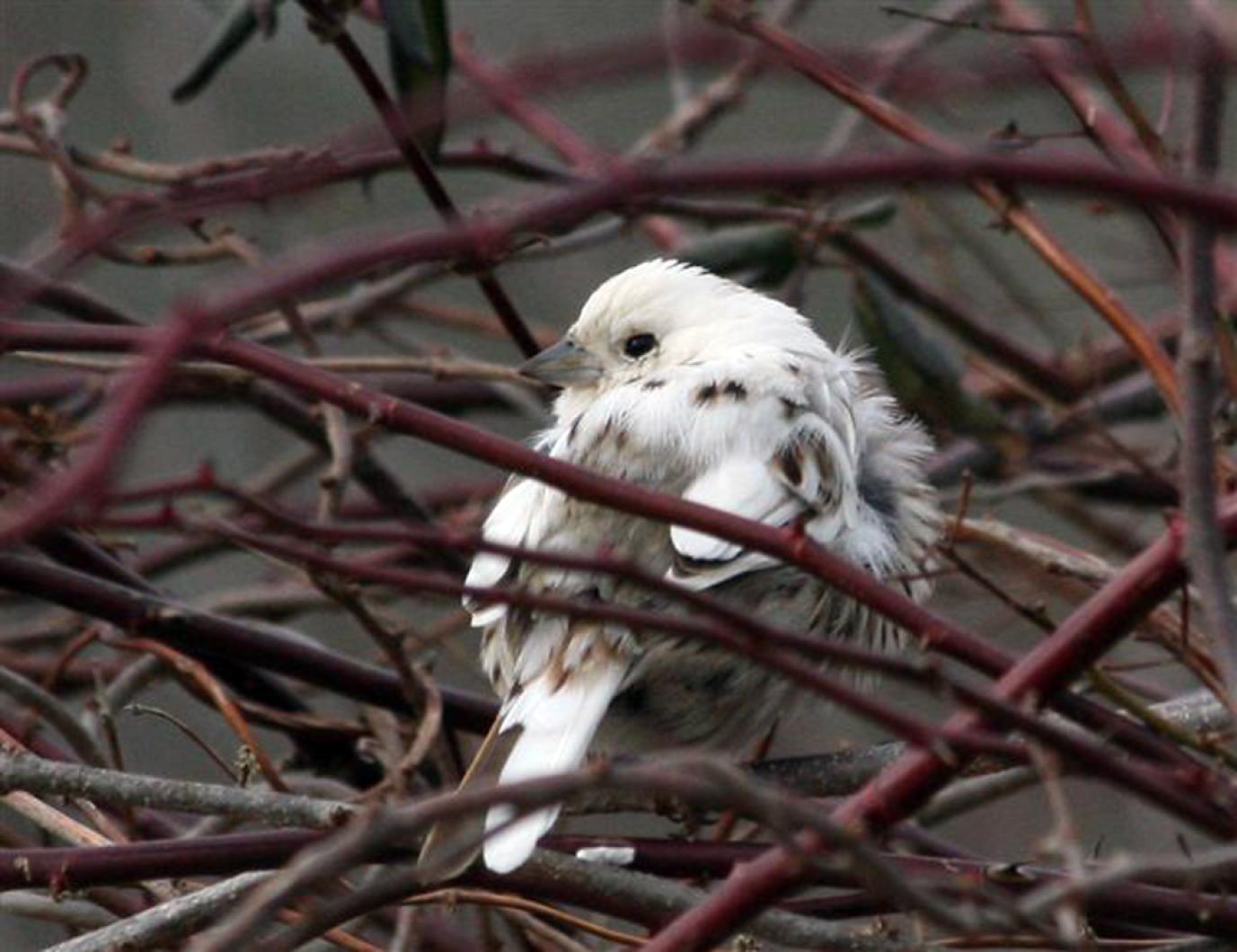A reminder: The Great Backyard Bird Count starts today, Feb. 12, and continues through Monday, Feb.15. For details on the count, visit birdcount.org,
Leucism: it’s a fifty cent word: Loosely translated, it means the bird has a pale plumage but not the stark white and red eyes of an albino. That seems simple enough, but there are many birds seen on the Vineyard that have white patches mixed in with their normal plumage. Are these partial albinos or partially leucistic? The Cornell Lab of Ornithology feels that partially white birds should be called pied. Both leucistic and pied birds possess a genetic defect; a lack of melanin that interferes with the growth of normal-colored plumage.
Over the years I have received photos and sighting reports of many leucistic birds on the Vineyard. They have included black-capped chickadees, blue jays, American robins, northern cardinals and house finches, to name a few. Most recently Meg Spokus sent me a photo of a leucistic black-capped chickadee that Doris Hamel spotted at her feeder in Aquinnah the week of Feb. 1. Lanny McDowell photographed a leucistic song sparrow that has been hanging around the fields just west of Chilmark Pond for a couple of years. These sightings made me wonder, is leucism more common on islands than on the mainland? I asked Wayne Petersen of the Massachusetts Audubon Society for his opinion. The following was his answer: “As for the question of insularity and whether leucistic individuals are more likely to maintain themselves in such ‘closed systems,’ I really can’t say. I think the question is really more of a genetic issue in terms of whether leucism is a condition that’s genetically passed on, or simply an anomaly. Assuming it’s an anomaly, I don’t think insularity really matters much. In other words, I suspect that a lucino showing up on an island may not really be anissue. Rather, I think the fact that such anomalous individuals may have a greater chance of being observed more than once on a relatively small island is really the question. I think a lot these aberrant indivi duals are more likely to go undetected in larger landscapes.”
So we probably notice pied or leucistic birds more than they do on the mainland. I think it would be interesting if everyone on the Vineyard who has seen a pied or leucistic bird reported it to the Great Backyard Bird Count. The data they have collected so far shows leucism is relatively unusual in birds. Again, that Web site is birdcount.org.
Bird Sightings:
David Damroth of Chilmark called in an unusual sighting he had on Jan. 21. He was in the Chilmark hills that evening and watched American woodcocks flying up and making their twittering call. These birds probably took advantage of a January thaw, using the mild temperatures to practice their springtime efforts. After checking with Gus Ben David and Vineyard Birds II, I learned that American woodcocks usually do not start their breeding flights and “peet” calls until March, and that they lay their eggs in April. Woodcocks do linger into the winter months and it is not unusual to find a few on our Christmas Bird Counts. Luanne Johnson and Liz Baldwin flushed a chunky bird out of Self’s Pond on Chappaquiddick on Feb. 7, which they identified as an American woodcock. I hope they make it through this snowstorm!
Nancy Weaver and Margaret Curtin spotted a cold but healthy great blue heron at Duarte Pond Feb. 1. Margaret, Rob Culbert, Lanny McDowell, Gus Ben David and others all are enjoying the waterfowl collection gathered at the open water at the head of the Lagoon in Oak Bluffs. Ring-necked ducks, American wigeon, and northern pintails are the favorites.
Richard Coutinho had a pair of bluebirds in his West Tisbury yard Feb. 7. Luanne Johnson counted seven eastern bluebirds enjoying her heated birdbath in North Tisbury on Feb. 9.
Allan Keith found two chipping sparrows at the Chilmark post office on Feb. 2. During a trip back to the Island on the ferry Feb. 7, he counted over 5000 common eiders, one black-legged kittiwake and a lovely close-at-hand view of a common murre.
Michael Cutler spotted a ruby-crowned kinglet in his Christiantown yard on Feb. 3. He noted that this was the first one he had seen in his yard in the thirty years he had lived there.
Rob Pecchia and Lara Crystal-Ornelas watched common eiders swim around the ferry on Feb. 6 and counted three male and one female bufflehead in Oak Bluffs. It appears that the eiders are spending more time in the Sound than off Gay Head.
Happy Spongberg reports that a first year male red-winged blackbird joined her black-capped chickadees for the first time this winter on Feb. 5. Gus Ben David is feeding close to 75 American goldfinches on this thistle feeder. He has Eastern bluebirds on his suet and his pine warbler comes and goes.
Lanny McDowell counted five brant at Menemsha and also noted the common eiders feeding in the channel. There are also numbers of brant at the Inkwell Beach in Oak Bluffs.
Please report your sightings to the M.V. Bird Hotline at 508-627-4922 or birds@mvgazette.com.
Susan B. Whiting is the co-author of Vineyard Birds and Vineyard Birds II. Her Web site is vineyardbirds.com .




Comments
Comment policy »